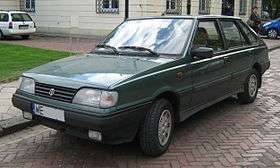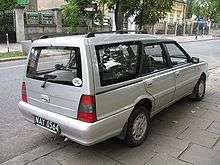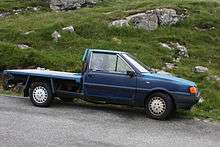FSO Polonez
| FSO Polonez | |
|---|---|
 | |
| Overview | |
| Manufacturer | FSO |
| Also called |
|
| Production |
1978-1991 (MR'78-89) 1991-1997 (Caro (sedan and hatchback)) 1997-2002 (Caro Plus (sedan, hatchback and wagon)) |
| Assembly | |
| Designer |
|
| Body and chassis | |
| Class | Large family car |
| Body style |
|
| Layout | FR layout |
| Related | |
| Powertrain | |
| Engine | |
| Transmission |
|
| Dimensions | |
| Wheelbase | 2,509 mm (98.8 in) |
| Length | 4,318 mm (170.0 in) |
| Width | 1,650 mm (65.0 in) |
| Height | 1,420 mm (55.9 in) |
| Curb weight | 1,075 kg (2,370 lb)-1,115 kg (2,458 lb) |
| Chronology | |
| Predecessor | Polski Fiat 125p |
The FSO Polonez was a Polish motor vehicle that was produced from 1978 to 2002. The car's name comes from the Polish dance, polonaise.
Background
The Polonez was a rebodied Polski Fiat 125p that Fabryka Samochodów Osobowych (FSO) built under license from Fiat. The internal components, including modernized 1.3/1.5 Litre engines, (pistons and carburetor), the chassis, and other mechanicals, were from the Polski Fiat 125p, but the body was an entirely new hatchback body designed by Giorgetto Giugiaro. The car was meant to be equipped with Fiat's 2.0 Litre DOHC engines in the 1980s, but financial problems at the time made the purchase of a license from Fiat impossible. This is also why the 125p was produced simultaneously with the Polonez for more than a decade. Moreover, mechanical modernization only took place when it could be applied to both cars. This situation finally changed after the production of the 125p ended in 1991.
An advantage of Polonez is its passive safety. In 1978, it was the only East European car built to pass U.S. crash tests. Crash tests were performed in 1994 according to EU safety regulations so that the Polonez could be exported worldwide. They proved the car to be very safe. The Caro 1.9 GLD hitting a concrete block (without an energy-absorbing metal cage) with 40% of the front at 50 km/h (31 mph) survived very well. All doors could be opened without any difficulty, there were no critical injuries for passengers, and no fuel leakage occurred.
Polonez range
The Polonez range was expanded to encompass a wide range of bodies. These included:
- Hatchback (as originally introduced)
- Sedan (FSO Polonez Atu, also known as FSO Celina on some export markets) introduced 1996 (first presented 1994)
- Station wagon (sold in some markets as the FSO Caro) introduced 1999 (first presented 1994)
- Pick-up called Truck (introduced 1987)
- Extended Pick-up (with small rear seats)
- Truck Roy (long body like Caro/Atu but in pick-up form) (introduced around 1997)
- Special-bodied service vehicle
- Special edition for the Polish Fire Brigade
- Cargo (Polonez Caro with higher roof and longer rear part made of PVC put on metal crates - this body is what the Ambulance was built on) introduced around 1993
- Coupe (three doors, about 50 made, side doors and B pillar are wider, C pillar is different)
- Three-doors (like normal Polonez but lacks rear doors, it is estimated that 300-1000 were made)
There were also many prototypes including: pickup made using rear part of Fiat 125p pick-up, native-looking pickup (w/o frame in the rear like actual Truck), 4x4 offroader (Analog), hydro-pneumatic suspension, Sedan (very different from Atu/Celina), 4x4 Truck w/o offroad suspension.
Polonez history
Development
- 1970 Fiat launched ESV (European Safety Vehicle) project.
- 1974 FSO chose Fiat's ESV prototype as base of new car. FSO's designer Zbigniew Watson joins Giorgetto Giugiaro and Walter de Silva to convert ESV project to the size of Fiat 125 floor and design interior and all body details. Project known as "type 137".
- 1975 Fiat prepared prototypes of type 137 named "Polski" and sent them to FSO.
Debut
In May 1978, mass production commenced. The official premiere of the FSO Polonez 1500 and FSO Polonez 1300 took place. The FSO Polonez 2000 Rally with a 2-liter Fiat DOHC engine was displayed. In 1979 the FSO Polonez 2000, sold mostly to government officials, appeared. The Polonez 2000 has a Fiat twin-cam engine with 1,995 cc, 82 kW (110 hp), a 5-speed gearbox, a 0–100 km/h acceleration of 12.0 seconds, and a 175 km/h (109 mph) top speed. The FSO Polonez 2000 Rally debuted in the Rallye Monte Carlo. In 1980 the FSO Polonez 1300 and 1500 three-door appeared. With the same short front doors as the five-door version, it was produced in 1980-1983 in about 300 units.
In 1981, the FSO Polonez in economy version was added. This was sold without black side rubbing strips between the front and rear wheel, chrome bumper strips, rear window wiper-washer, fog lamps, luggage cover, and rev counter. Plain vinyl was used on the seats and in the luggage compartment. At the other end appeared the top version, FSO Polonez 1500 X. This was fitted with the AB 1,481 cc engine of 60 kW (80 hp), a five-speed gearbox (final drive ratio 4:3), and a radio. It was sold in the domestic market, usually for U.S. dollar payments.
In 1982, the FSO Polonez 1500 Coupé with proper three-door bodywork was introduced. It had the usual 1,481 cc engine with 60 kW (80 hp). It was the first FSO model to feature electronic ignition and fuel economiser owing to supply of pre-heated air to suction manifold. Only a few dozen were produced.

.jpg)


In 1983 The Polski Fiat 125p was renamed FSO 125p, after FSO's licence rights to the Fiat badge expired. The new naming system for FSO's models was as follows:
- FSO 125p: 1.3 L, 1.3 ML, 1.3 ME, 1.5 C, 1.5 L, 1.5 ML, 1.5 MS, 1.5 ME
- FSO Polonez 1.3 C, 1.3 CE, 1.3 L, 1.3 LE, 1.5 C, 1.5 CE, 1.5 L, 1.5 LS, 1.5 LE, 1.5 X, 2000.
Also in 1983, the FSO Polonez 2.0 D Turbo with an Italian VM Motori HR 488 engine of 1,995 cc appeared. It produces 62 kW (83 hp) at 4,300 rpm and 163 N·m (120 lb·ft) at 2,500 rpm. Final drive ratio is 3,727, for a 0–100 km/h acceleration time of 20,0 s, and a top speed of 146 km/h (91 mph). Fuel consumption is 7,1/10,6/10,0 l/100 km, approximately 100 cars were produced to this specification.
- 1984 FSO Polonez 2000 Turbo 3-door - rally car, never got rally homologation, bodywork like Coupé version, but without the Coupé-like front. This car received a turbocharged 1,995 cc Fiat engine, in some variants combined with a supercharger for better torque.
- 1985 FSO Polonez - first five-door cars with a Coupé-like front
- 1986 FSO Polonez 1.5 Turbo mass production launched. Also a rally version 1.5C Turbo known as "Iron Rain" official premiere.
FSO 125p 1.6 D with a 1,588 cc Volkswagen diesel engine, producing 40 kW (54 hp) at 4,800 rpm and 100 N·m (74 lb·ft) at 2,300 rpm. 0–100 km/h acceleration took 25,2 seconds, and top speed is 125 km/h (78 mph). Fuel consumption was reported as 5,4/9,3/7,4, with the price in Poland being about $4,500 at the time.
FSO Polonez - first cars with additional rear-side windows in the C-pillar.
In 1987, the FSO Polonez 1.6 LE appeared. It has a 1,598 cc inline-four with 64 kW (86 hp) at 5,200 rpm and 132 N·m (97 lb·ft) at 3,800 rpm. Top speed is 155 km/h (96 mph). There was also the rare FSO 125p 1.6 ME, with the same engine but a top speed of 157 km/h (98 mph). Very few were made.
FSO Polonez modifications: stamped rear spoiler instead of plastic one, new model labels on the sticking foil, new version coding system with an 'S' supposedly meaning that the car had the additional rear-side windows in the C-pillar, a rule often broken in practice. The versions available were:
1,3 SCE, 1.3 SL, 1.3 SLE, 1,5 CE, 1.5 L, 1,5 LE, 1,5 SCE, 1,5 SL, 1,5 SLE, 1,6 SLE, 2.0 SLE
In 1988, the FSO Polonez 1500 Turbo with AA 1,481 cc engine, 188 hp (140 kW) at 7,000 rpm, 240 N·m (177 lb·ft) at 3,200 rpm, 8,5 s, 220 km/h (137 mph) appeared. This was a rally version only, built to group A specifications. Following this competition version the FSO Polonez 1.5 SLE Turbo with turbocharged AA engine appeared in December 1989. With a compression ratio of 8.5 to 1, the 1,481 cc inline-four produces 105 hp (78 kW) at 6,000 rpm, and 180 N·m (133 lb·ft) at 3,200 rpm. The 100 km/h sprint was discharged in 11,0 s and the top speed is 180 km/h (112 mph). A catalyzed version with 94 hp (70 kW) was also available.[1] The Turbo Polonez' were built mainly in rally versions (group N), although on special request a Turbo-kit could be installed in mass-produced cars.
- 1988 Prototypes of the FSO Polonez in ambulance and van versions based on the FSO Truck (pick-up). Lowered chassis and an additional right-side door were added features.
In 1989, the '89 FSO Polonez appeared, the facelift included a rear trunk lid lowered to the bumper level, new rear lamps, rear window wiper-washer placed horizontally, and side repeaters placed horizontally near front doors. In January 1989, the first catalyzed Polonezes (1500 only) were shown at the Amsterdam Auto Show.[2] Simultaneously, a version with an Italian FNM-built (Fratelli Negri Motori) 1,366 cc (1.4 L) turbodiesel and a five-speed manual appeared (called the "Polonez Piedra 1.3 Turbodiesel"), specifically for the Belgian market. This engine has 60 PS (44 kW) at 4,500 rpm, enough for a top speed of 155 km/h (96 mph).[1]
1990
In 1990, the FSO Polonez 2.0 SLE appeared, fitted with Ford's 77 kW (103 hp) 2.0 litre engine, 12,5 seconds acceleration to 100 km/h and a top speed of 165 km/h (103 mph).
1991 marked the end of FSO 125p production. Along with this, FSO's 1,295 cc engine ended production. FSO imports to the United Kingdom were temporarily stopped. On the other hand, the facelifted FSO Polonez Caro appeared. It had new headlamps and grille (similar to the design of the FSO Wars, a prototype car supposed to be successor to Polonez), new front and rear bumpers, steering wheel, new rooflet over instruments, and improved front crash safety. Also new was the FSO Polonez Caro 1.9 GLD with Citroën's 1,905 cc diesel engine, 50 kW (67 hp), 120 N·m (89 lb·ft), and a top speed of 140 km/h (87 mph). The Caro GLD was sold across mainland Europe.
The other versions in pricelist:
- FSO Polonez Caro 1.5 GLE - 60 kW (80 hp)
- FSO Polonez Caro 1.6 GLE - 64 kW (86 hp)
- FSO Polonez Caro 2.0 GLE - Ford's 77 kW (103 hp) engine and gearbox from the Ford Sierra (approx. 1,000 units)
- 1992 FSO Polonez 1.5 GLI, 1.6 GLI with ABIMEX single point injection, with or without catalytic converter.
- 1993 (August) Polonez after the next facelift: front and rear track 60 mm (2.4 in) wider, fresh air inlet moved from hood to the front of the windscreen, better front and rear wipe-wash kinematics, longer arms and larger wiped area, changes in the dashboard: circular speedometer and rev counter, four instead of two fresh air outlets, illuminated switches and remote headlamps shaft regulator.
(December) FSO Polonez 1.4 GLI 16V with Rover 1396 cc engine, 76 kW (102 hp) @ 6000 rpm, 127 N·m (94 lb·ft) @ 5000 rpm, 11,9 s, 178 km/h (111 mph), with or without catalytic converter.
- 1994 FSO (Prima) 1.4 GLI 16V - race car with Rover 1396 cc engine, 92 kW (123 hp) @ 7200 rpm, 130 N·m (96 lb·ft) @ 6000 rpm, 205 km/h (127 mph), took part in Dutch race competitions.
FSO Polonez Sedan prototype - later produced as the FSO Atu - with 4-door limousine bodywork, with completely new dashboard and upholstery (project by FSO), new rear suspension: rigid rear axle with longitudinal wishbones, reaction bars and coil springs. Rear lamps same as in Caro version.
Two prototypes of the FSO Polonez Kombi (station wagon). The next prototype: FSO Analog 4WD, light off-road car with 4-door pick-up bodywork and four wheel drive.
Export to the UK restarted: FSO Caro (Polonez 1.6 and 1.9 D) and FSO Pick-up (Truck)
- 1995 The next prototype of the 4-door FSO Polonez Sedan introduced on the 1995 Poznan Motor Show - the car had new a dashboard (see 1994) and new rear lamps.
Girling-Lucas brakes introduced.
- 1996 (February) First series of the new FSO Atu 1.6 GLI sold - produced from December 1995 to February 1996. (June) Mass production of the FSO Polonez Atu 1.6 GLI and FSO Polonez Atu 1.4 GLI 16V, very few cars in FSO Polonez Atu 1.9 GLD specification with Diesel engine. The FSO Atu renamed to FSO Polonez Atu after protests by the ATU insurance company.
Production of the FSO Polonez Caro 1.9 GLD stopped.
- 1997 (March) FSO Polonez mass production of the new Caro Plus and Atu Plus - the new front grill, bumpers, new dashboard.
(summer) End of export to the Netherlands, the last foreign market for Polonez passenger versions; the last offering in the Netherlands consisted of:
- FSO Prima (Polonez Caro) 1.6 GLI
- FSO Prima (Polonez Caro) 1.4 GLI 16V
- FSO Celina (Atu) 1.6 GLI
(August) The first Daewoo-FSO Lanos 1.5 S 4d leaves the FSO assembly line.(December) FSO Polonez Caro Plus and Atu Plus 1.6 GSI - with Delphi (Multec XM) multi-point fuel injection, 1598 cc 62 kW (83 hp), 130 N·m (96 lb·ft), ca. 155 km/h (96 mph), new door handles introduced.
- 1998 (May) The first public show of the station wagon prototype: FSO Polonez Kombi Plus.
FSO Truck sold in Italy by Daewoo dealer network.

- 1999 (February) The test production of the new Daewoo-FSO Polonez Kombi 1.6 GSi MPI. (April) The mass production of the Daewoo-FSO Polonez Kombi in passenger (final drive ratio 3,9) and van version (final drive ratio 4,3) with 1.6 engine (MPI). The new steering wheel (From Daewoo Nubira), arm-rests introduced. Start of sale planned for June 1999. (May) Official premiere of the Daewoo-FSO Polonez Kombi 1.6 GSi MPI on the Poznan Motor Show.
- 2000 The new shape of the FSO label in the front grill. (summer) Approx. 200 FSO Polonez cars produced with air conditioning, sold in summer months for extra 1,200 PLN (alloy wheels included).
- 2001 (summer) Small series of FSO Polonez with air conditioning, sold in summer months for extra 1,000 PLN.
- 2002 (the end of first quarter) The last passenger FSO Polonez car leaves assembly line. Production has been stopped (meant to be stopped temporarily at first though). Daewoo-FSO did not make any official ceremony of the end of Polonez production.
- 2003 a new company, Polska Fabryka Samochodow (PFS) tried to restart Polonez Truck production, renamed to Poltruck (meant to have modified body, to be introduced a bit later though), but it eventually failed leaving only a limited amount of test cars.
Export markets


Polonez was exported to many countries, including Netherlands, Argentina, Bolivia, UK, China, Greece, Italy, Finland, Egypt (Complete knock down (CKD) were assembled in Egypt, and Polonez was still popular in Egypt through 2008), Spain, Portugal, and others. In the late 1980s, a batch of 150 Polonez hatchbacks was exported to New Zealand. They were also exported to Chile and Colombia (in the latter country as police cars and taxicabs) from the late 1980s to early 1990s. In some countries the FSO Polonez was sold as FSO Celina, FSO Prima, or FSO Caro.
Imports to the UK ceased in 1997, though sales continued in some parts of Western Europe - including France - for at least a year afterwards. They were withdrawn from those markets largely because of more stringent emissions requirements.
Legacy
The FSO Polonez suffered from relatively poor performance (except those with Fiat 2.0DOHC, Ford 2.0 SOHC and Rover 1.4MPI 16V). Polonez parts were relatively cheap and readily available. After 1992, quality began to increase, especially after 1995 when Daewoo started its cooperation with FSO. The last production models, the PLUS series since 1997 offered new features such as air conditioning.
Production ended, 24 years after it had begun. The relatively low price of the Polonez was seen as the main advantage over other cars. Demand slumped and the last versions of the Polonez produced were the Truck versions, valued for their low price, reliability and high load capability (up to 1,000 kg (2,205 lb) depending on the version).
The Polonez was a common sight in Central and Eastern Europe, particularly in its home country of Poland, but since Poland joined the European Union in May 2004, the car was rapidly replaced by relatively cheap, tax free, and more modern used cars from Western Europe.
References
- 1 2 Tutte le Auto del Mondo 1990, p. 321
- ↑ Tutte le Auto del Mondo 1990, p. 320
- Mastrostefano, Raffaele, ed. (1990). Quattroruote: Tutte le Auto del Mondo 1990 (in Italian). Milano: Editoriale Domus S.p.A.
External links
| Wikimedia Commons has media related to FSO Polonez. |